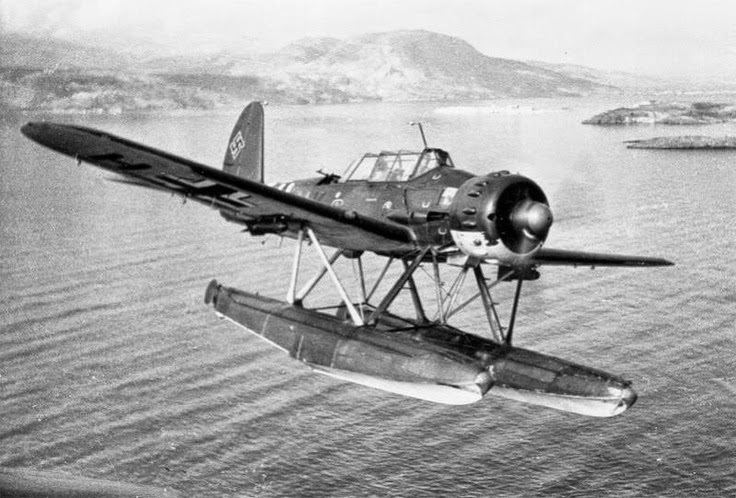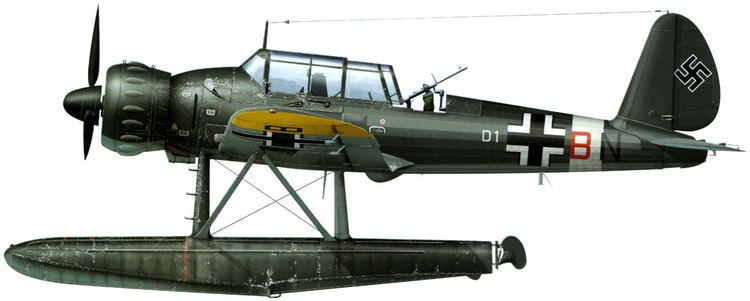Top speed 311 km/h Wingspan 12 m Cruise speed 255 km/h First flight May 1937 | Range 1,070 km Length 11 m | |
 | ||
Arado ar 196 seaplane
The Arado Ar 196 was a shipboard reconnaissance low-wing monoplane aircraft built by the German firm of Arado starting in 1936. The next year it was selected as the winner of a design contest and became the standard aircraft of the Kriegsmarine (German navy) throughout World War II.
Contents
- Arado ar 196 seaplane
- Design and development
- Operational history
- Arado in Allied hands
- Former military operators
- Aircraft on display
- Specifications Ar 196 A 2
- References

Arado ar 196 seaplane
Design and development

In 1933, the Kriegsmarine looked for a standardized shipboard reconnaissance aircraft. After a brief selection period, the Reichsluftfahrtministerium (German Air Ministry, RLM) decided on the Heinkel He 60 biplane. This was one of a line of developments of a basic biplane airframe that appeared as a number of floatplanes, trainers, and fighters. Deliveries started in a matter of months.

By 1935, it was found that the He 60's performance was lacking and the RLM asked Heinkel to design its replacement. The result was the He 114. The first prototype was powered by the Daimler-Benz DB 600 inline engine, but it was clear that supplies of this engine would be limited and the production versions turned to the BMW 132 radial engine instead.

The plane proved to have only slightly better performance than the He 60, and its sea-handling was poor. Rushed modifications resulted in a series of nine prototypes in an attempt to solve some of the problems, but they didn't help much. The Navy gave up, and the planes were eventually sold off to Romania, Spain and Sweden.
In October 1936, the RLM asked for a He 114 replacement. The only stipulations were that it would use the BMW 132, and they wanted prototypes in both twin-float and single-float configurations. Designs were received from Dornier, Gotha, Arado and Focke-Wulf. Heinkel declined to tender, contending that the He 114 could still be made to work.
With the exception of the Arado low-wing monoplane design, all were conventional biplanes. That gave the Arado better performance than any of the others and the RLM ordered four prototypes. The RLM was also rather conservative by nature, so they also ordered two of the Focke-Wulf Fw 62 design as a backup. It quickly became clear that the Arado would work effectively, and only four prototypes of the Fw 62 were built.
The Ar 196 prototypes were all delivered in summer 1937, V1 (which flew in May) and V2 with twin floats as A models, and V3 and V4 on a single float as B models. Both versions demonstrated excellent water handling and there seemed to be little to decide one over the other. Since there was a possibility of the smaller outrigger floats on the B models "digging in", the twin-float A model was ordered into production. A single additional prototype, V5, was produced in November 1938 to test final changes.
10 A-0s were delivered in November and December 1938, with a single 7.92 mm (.312 in) MG 15 machine gun in the rear seat for defense. Five similarly equipped B-0s were also delivered to land-based squadrons. This was followed by 20 A-1 production models starting in June 1939, enough to equip the surface fleet.
Starting in November, production switched to the heavier land-based A-2 model. It added shackles for two 50 kg (110 lb) bombs, two 20 mm MG FF cannons in the wings, and a 7.92 mm (.312 in) MG 17 machine gun in the cowling. The A-4 replaced it in December 1940, strengthening the airframe, adding another radio, and switching props to a VDM model. The apparently mis-numbered A-3, which had additional strengthening of the airframe, replaced the A-4. The final production version was the A-5 from 1943, which changed radios and cockpit instruments, and switched the rear gun to the much-improved MG 81Z. Overall, 541 Ar 196s (15 prototypes and 526 production models) were built before production ended in August 1944, about 100 of these from SNCA and Fokker plants.
The Ar 196C was a proposed aerodynamically-refined version. The Ar 196C project was cancelled in 1941.
Operational history
The plane was loved by its pilots, who found it handled well both in the air and on the water. With the loss of the German surface fleet, the A-1s were added to coastal squadrons and continued to fly reconnaissance missions and submarine hunts into late 1944. Two notable operations were the capture of HMS Seal, and the repeated interception of RAF Armstrong-Whitworth Whitley bombers. Although it was no match for a fighter, it was considerably better than its Allied counterparts, and generally considered the best of its class. Owing to its good handling on water, the Finnish Air Force utilized Ar 196s just for transporting and supplying special forces patrols behind enemy lines, landing on small lakes in remote areas. Several fully equipped soldiers were carried in the fuselage.
Arado in Allied hands
The first Arado Ar 196 to fall into allied hands was an example belonging to the German cruiser Admiral Hipper, which was captured in Lyngstad, Eide, by a Norwegian Marinens Flyvebaatfabrikk M.F.11 seaplane of the Trøndelag naval district on 8 April 1940, at the dawn of the Norwegian Campaign. After being towed to Kristiansund by the torpedo boat HNoMS Sild, it was used against its former owners, flying with Norwegian markings. At 03:30 on 18 April, the Arado was evacuated to the UK by a Royal Norwegian Navy Air Service pilot. The plane was shortly thereafter crashed by a British pilot while on transit to the Helensburgh naval air base for testing. At the end of the war, at least one Arado Ar 196 was left at a Norwegian airfield and kept in use as a liaison aircraft by the Royal Norwegian Air Force for a year on the West coast.
Former military operators
Aircraft on display
The Aircraft Historical Museum, Sola, Norway, has on display an Ar 196 A-2 fuselage frame raised from the wreck of the German cruiser Blücher in Oslofjord.
Another aircraft is known to lie in the Jonsvatnet, a lake near Trondheim in Norway. A number of wartime German aircraft have been recovered from the lake, but the Ar 196 remains undisturbed as its crew were killed when it crashed there in 1940 and it has the status of a War Grave.
A wrecked Arado Ar 196 A-3, believed to be D1 + EH, was snagged by a fishing trawler off the island of Irakleia in 1982 at a depth of 91 meters. It was towed out of the fishing lanes to shallower waters (about 11 meters). The upside down plane, with fuselage and wings mostly intact, has become a popular spot for Scuba diving.
Specifications (Ar 196 A-2)
Data from
General characteristics
Performance
Armament
